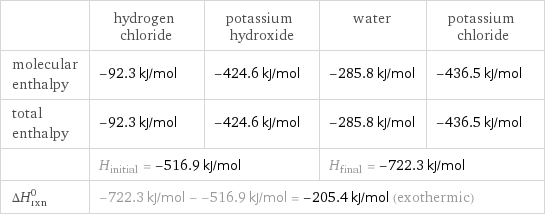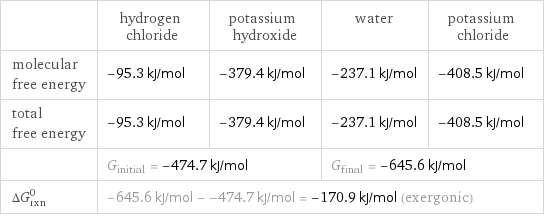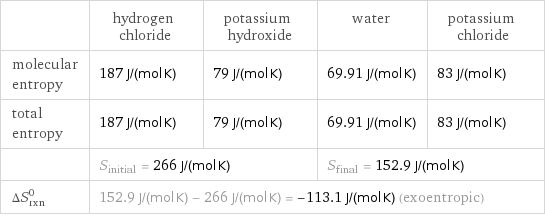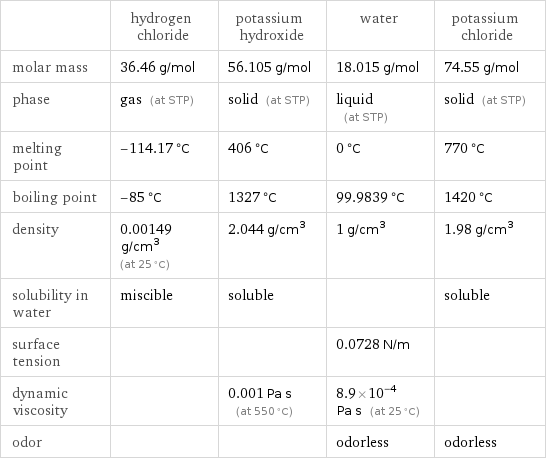Input interpretation

HCl (hydrogen chloride) + KOH (potassium hydroxide) ⟶ H_2O (water) + KCl (potassium chloride)
Balanced equation

Balance the chemical equation algebraically: HCl + KOH ⟶ H_2O + KCl Add stoichiometric coefficients, c_i, to the reactants and products: c_1 HCl + c_2 KOH ⟶ c_3 H_2O + c_4 KCl Set the number of atoms in the reactants equal to the number of atoms in the products for Cl, H, K and O: Cl: | c_1 = c_4 H: | c_1 + c_2 = 2 c_3 K: | c_2 = c_4 O: | c_2 = c_3 Since the coefficients are relative quantities and underdetermined, choose a coefficient to set arbitrarily. To keep the coefficients small, the arbitrary value is ordinarily one. For instance, set c_1 = 1 and solve the system of equations for the remaining coefficients: c_1 = 1 c_2 = 1 c_3 = 1 c_4 = 1 Substitute the coefficients into the chemical reaction to obtain the balanced equation: Answer: | | HCl + KOH ⟶ H_2O + KCl
Structures

+ ⟶ +
Names

hydrogen chloride + potassium hydroxide ⟶ water + potassium chloride
Reaction thermodynamics
Enthalpy

| hydrogen chloride | potassium hydroxide | water | potassium chloride molecular enthalpy | -92.3 kJ/mol | -424.6 kJ/mol | -285.8 kJ/mol | -436.5 kJ/mol total enthalpy | -92.3 kJ/mol | -424.6 kJ/mol | -285.8 kJ/mol | -436.5 kJ/mol | H_initial = -516.9 kJ/mol | | H_final = -722.3 kJ/mol | ΔH_rxn^0 | -722.3 kJ/mol - -516.9 kJ/mol = -205.4 kJ/mol (exothermic) | | |
Gibbs free energy

| hydrogen chloride | potassium hydroxide | water | potassium chloride molecular free energy | -95.3 kJ/mol | -379.4 kJ/mol | -237.1 kJ/mol | -408.5 kJ/mol total free energy | -95.3 kJ/mol | -379.4 kJ/mol | -237.1 kJ/mol | -408.5 kJ/mol | G_initial = -474.7 kJ/mol | | G_final = -645.6 kJ/mol | ΔG_rxn^0 | -645.6 kJ/mol - -474.7 kJ/mol = -170.9 kJ/mol (exergonic) | | |
Entropy

| hydrogen chloride | potassium hydroxide | water | potassium chloride molecular entropy | 187 J/(mol K) | 79 J/(mol K) | 69.91 J/(mol K) | 83 J/(mol K) total entropy | 187 J/(mol K) | 79 J/(mol K) | 69.91 J/(mol K) | 83 J/(mol K) | S_initial = 266 J/(mol K) | | S_final = 152.9 J/(mol K) | ΔS_rxn^0 | 152.9 J/(mol K) - 266 J/(mol K) = -113.1 J/(mol K) (exoentropic) | | |
Equilibrium constant
![Construct the equilibrium constant, K, expression for: HCl + KOH ⟶ H_2O + KCl Plan: • Balance the chemical equation. • Determine the stoichiometric numbers. • Assemble the activity expression for each chemical species. • Use the activity expressions to build the equilibrium constant expression. Write the balanced chemical equation: HCl + KOH ⟶ H_2O + KCl Assign stoichiometric numbers, ν_i, using the stoichiometric coefficients, c_i, from the balanced chemical equation in the following manner: ν_i = -c_i for reactants and ν_i = c_i for products: chemical species | c_i | ν_i HCl | 1 | -1 KOH | 1 | -1 H_2O | 1 | 1 KCl | 1 | 1 Assemble the activity expressions accounting for the state of matter and ν_i: chemical species | c_i | ν_i | activity expression HCl | 1 | -1 | ([HCl])^(-1) KOH | 1 | -1 | ([KOH])^(-1) H_2O | 1 | 1 | [H2O] KCl | 1 | 1 | [KCl] The equilibrium constant symbol in the concentration basis is: K_c Mulitply the activity expressions to arrive at the K_c expression: Answer: | | K_c = ([HCl])^(-1) ([KOH])^(-1) [H2O] [KCl] = ([H2O] [KCl])/([HCl] [KOH])](../image_source/f708313cf9bb1fd23be57cc9040078ea.png)
Construct the equilibrium constant, K, expression for: HCl + KOH ⟶ H_2O + KCl Plan: • Balance the chemical equation. • Determine the stoichiometric numbers. • Assemble the activity expression for each chemical species. • Use the activity expressions to build the equilibrium constant expression. Write the balanced chemical equation: HCl + KOH ⟶ H_2O + KCl Assign stoichiometric numbers, ν_i, using the stoichiometric coefficients, c_i, from the balanced chemical equation in the following manner: ν_i = -c_i for reactants and ν_i = c_i for products: chemical species | c_i | ν_i HCl | 1 | -1 KOH | 1 | -1 H_2O | 1 | 1 KCl | 1 | 1 Assemble the activity expressions accounting for the state of matter and ν_i: chemical species | c_i | ν_i | activity expression HCl | 1 | -1 | ([HCl])^(-1) KOH | 1 | -1 | ([KOH])^(-1) H_2O | 1 | 1 | [H2O] KCl | 1 | 1 | [KCl] The equilibrium constant symbol in the concentration basis is: K_c Mulitply the activity expressions to arrive at the K_c expression: Answer: | | K_c = ([HCl])^(-1) ([KOH])^(-1) [H2O] [KCl] = ([H2O] [KCl])/([HCl] [KOH])
Rate of reaction
![Construct the rate of reaction expression for: HCl + KOH ⟶ H_2O + KCl Plan: • Balance the chemical equation. • Determine the stoichiometric numbers. • Assemble the rate term for each chemical species. • Write the rate of reaction expression. Write the balanced chemical equation: HCl + KOH ⟶ H_2O + KCl Assign stoichiometric numbers, ν_i, using the stoichiometric coefficients, c_i, from the balanced chemical equation in the following manner: ν_i = -c_i for reactants and ν_i = c_i for products: chemical species | c_i | ν_i HCl | 1 | -1 KOH | 1 | -1 H_2O | 1 | 1 KCl | 1 | 1 The rate term for each chemical species, B_i, is 1/ν_i(Δ[B_i])/(Δt) where [B_i] is the amount concentration and t is time: chemical species | c_i | ν_i | rate term HCl | 1 | -1 | -(Δ[HCl])/(Δt) KOH | 1 | -1 | -(Δ[KOH])/(Δt) H_2O | 1 | 1 | (Δ[H2O])/(Δt) KCl | 1 | 1 | (Δ[KCl])/(Δt) (for infinitesimal rate of change, replace Δ with d) Set the rate terms equal to each other to arrive at the rate expression: Answer: | | rate = -(Δ[HCl])/(Δt) = -(Δ[KOH])/(Δt) = (Δ[H2O])/(Δt) = (Δ[KCl])/(Δt) (assuming constant volume and no accumulation of intermediates or side products)](../image_source/01129615c768f074ded05c9f604a28ff.png)
Construct the rate of reaction expression for: HCl + KOH ⟶ H_2O + KCl Plan: • Balance the chemical equation. • Determine the stoichiometric numbers. • Assemble the rate term for each chemical species. • Write the rate of reaction expression. Write the balanced chemical equation: HCl + KOH ⟶ H_2O + KCl Assign stoichiometric numbers, ν_i, using the stoichiometric coefficients, c_i, from the balanced chemical equation in the following manner: ν_i = -c_i for reactants and ν_i = c_i for products: chemical species | c_i | ν_i HCl | 1 | -1 KOH | 1 | -1 H_2O | 1 | 1 KCl | 1 | 1 The rate term for each chemical species, B_i, is 1/ν_i(Δ[B_i])/(Δt) where [B_i] is the amount concentration and t is time: chemical species | c_i | ν_i | rate term HCl | 1 | -1 | -(Δ[HCl])/(Δt) KOH | 1 | -1 | -(Δ[KOH])/(Δt) H_2O | 1 | 1 | (Δ[H2O])/(Δt) KCl | 1 | 1 | (Δ[KCl])/(Δt) (for infinitesimal rate of change, replace Δ with d) Set the rate terms equal to each other to arrive at the rate expression: Answer: | | rate = -(Δ[HCl])/(Δt) = -(Δ[KOH])/(Δt) = (Δ[H2O])/(Δt) = (Δ[KCl])/(Δt) (assuming constant volume and no accumulation of intermediates or side products)
Chemical names and formulas

| hydrogen chloride | potassium hydroxide | water | potassium chloride formula | HCl | KOH | H_2O | KCl Hill formula | ClH | HKO | H_2O | ClK name | hydrogen chloride | potassium hydroxide | water | potassium chloride
Substance properties

| hydrogen chloride | potassium hydroxide | water | potassium chloride molar mass | 36.46 g/mol | 56.105 g/mol | 18.015 g/mol | 74.55 g/mol phase | gas (at STP) | solid (at STP) | liquid (at STP) | solid (at STP) melting point | -114.17 °C | 406 °C | 0 °C | 770 °C boiling point | -85 °C | 1327 °C | 99.9839 °C | 1420 °C density | 0.00149 g/cm^3 (at 25 °C) | 2.044 g/cm^3 | 1 g/cm^3 | 1.98 g/cm^3 solubility in water | miscible | soluble | | soluble surface tension | | | 0.0728 N/m | dynamic viscosity | | 0.001 Pa s (at 550 °C) | 8.9×10^-4 Pa s (at 25 °C) | odor | | | odorless | odorless
Units
